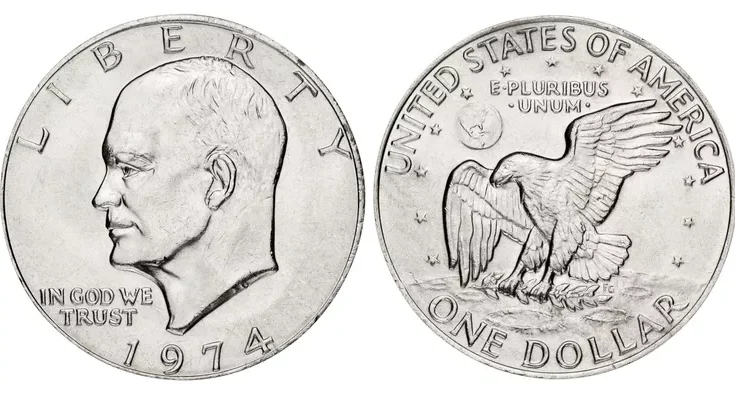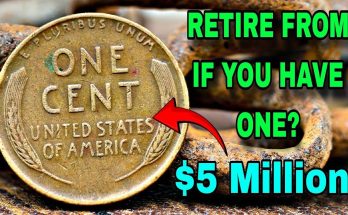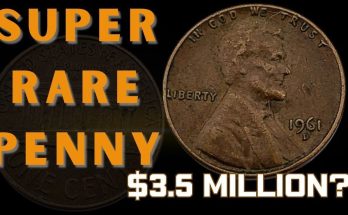The United States Mint first produced Eisenhower silver dollars in 1971 to honor the late president and World War II hero. On April 29, 1969, Congressman Robert Casey of Texas introduced legislation mandating this new one-dollar coin. On October 29, 1969, Congressman Robert R. Casey proposed another bill to define the reverse of the new dollar coin as a tribute to the Apollo 11 Moon landing. Production continued until 1978. Although the Eisenhower or “Ike” one-dollar coin never circulated widely, it is becoming more popular among coin collectors.
Since more coin collectors are starting to collect the “Ike” series, this increased collector interest has led to the discovery of multiple die varieties and errors. However, not all are listed in standard coin catalogs and value guides. Instead, the editors of these guides usually wait until collector interest in a particular die variety or error rises to the level of attention that conventional collectors would want to know the value. Additionally, editors of coin value guides need to have an adequate volume of sales history to publish a value.
One of the most valuable Eisenhower dollars is the 1972 Type 2, which is easily identifiable by looking at the image of the moon on the reverse. You can study this popular Eisenhower silver dollar and other varieties and errors by reviewing our key dates, rarities, and varieties guide below. Then, start adding them to your collection.
-
01of 07
1971-S Proof Eisenhower Dollar – Normal “R”
:max_bytes(150000):strip_icc():format(webp)/US0100-1971-S-Eisenhower-Ike-Dollar-Proof-Normal-R-56a1783b3df78cf7726af6f2.jpg)
James Bucki On most San Francisco 1971-S Proof Eisenhower dollar issues, the “R” in LIBERTY has a serif at the bottom of the vertical leg. Two artistic protrusions quickly identify this from the bottom of the vertical leg on the R. These coins were struck early in the life of the die before they began to wear out. The strike and cameo contrast are usually bold and clear. The 1971-S Proof Eisenhower Dollar is the most common die variety because it is made exactly as the designer created it.
-
02of 07
1971-S Proof Eisenhower Dollar – Peg Leg “R”
:max_bytes(150000):strip_icc():format(webp)/US0100-1971-S-Eisenhower-Ike-Dollar-Proof-Peg-Leg-R-56a1783b3df78cf7726af6f7.jpg)
James Bucki The rare variety of the San Francisco-minted 1971 Proof Eisenhower one-dollar coin does not have the serifs at the bottom of the vertical leg on the “R” in LIBERTY. Some researchers believe that this variety was caused by over-polishing the proof dies (a.k.a. die abrasion). Others think that a change in the coin hub created the master die. Regardless of the cause of this die variety, it is a rare coin and carries a premium over and above common strikes.
Read More: Ike Peg Legs FAQ from The Ike Group.
-
03of 07
1972 Eisenhower Dollar – Type 1 (Low Relief)
:max_bytes(150000):strip_icc():format(webp)/US0100-1972-Eisenhower-Ike-Dollar-Type-1-Desc-56a1783b5f9b58b7d0bf9bbb.jpg)
James Bucki The 1972 Philadelphia-minted Eisenhower dollar Type I reverse was used from January through August. You can identify this variety by looking at the three islands to the right of Florida, found on the Earth rising above the moon. Additionally, the Earth’s rim is flat from about eight to eleven o’clock, and the feathers on the eagle’s breast are raised and distinct.
Since this variety’s production run lasted nine months, it is the most common of the three varieties. Therefore, it carries little numismatic premium.
-
04of 07
1972 Eisenhower Dollar – Type 2 (High Relief)
:max_bytes(150000):strip_icc():format(webp)/US0100-1972-Eisenhower-Ike-Dollar-Type-2-Desc-56a1783c3df78cf7726af6fd.jpg)
James Bucki The 1972 Philadelphia-minted Ike Dollar Type 2 reverse is the rarest of all three varieties. It was created when the Mint mistakenly used a proof reverse die in August at the Philadelphia facility. Created from a single coin die and used in only one production run, this variety is identified by the absence of islands beneath Florida on the Earth rising above the moon. Instead of islands, three incuse lines look like water. Additionally, North America and South America seemed to fade out at the top and bottom of the earth.
Since the Mint used only one coin die to produce this variety, the estimated number of coins produced is under 100,000. Therefore, this is the most sought-after die variety in the Eisenhower Dollar series.
-
05of 07
1972 Eisenhower Dollar – Type 3 (Modified High Relief)
:max_bytes(150000):strip_icc():format(webp)/US0100-1972-Eisenhower-Ike-Dollar-Type-3-Desc-56a1783c5f9b58b7d0bf9bbe.jpg)
James Bucki The 1972 Type 3 Eisenhower dollar used a new reverse die created and used from September through the rest of the year. The islands on the Earth that are rising over the moon on the reverse of this variety appear beneath and to the left of Florida, and the overall relief and details of the Earth are strengthened. On most strikes, the Earth is completely defined and does not blend in with the field of the coin on the left-hand side. The eagle’s breast feathers are smooth but not well-defined. This variety is also known as the “Normal Reverse” in some publications.
-
06of 07
1976 Bicentennial Eisenhower Dollar – Type 1
:max_bytes(150000):strip_icc():format(webp)/US0100-1976-Eisenhower-Ike-Dollar-Type-1-56a1783a3df78cf7726af6e0.jpg)
Heritage Auction Galleries, Ha.com Due to the anticipated high demand for bicentennial coins by the citizens and the public, the United States Mint began producing the duel dated (1776-1976) Bicentennial Eisenhower dollars in 1975. Therefore, there are no Eisenhower dollars dated 1975. The Mint first used a reverse die with thick letters on UNITED STATES OF AMERICA and ONE DOLLAR. Unfortunately, problems getting the coins to strike up correctly persisted, and artists at the Mint had to rework the coin die. The easiest way to identify this variety is to look at the “T” in STATES. The horizontal bar in the “T” is squared at each end.
-
07of 07
1976 Bicentennial Eisenhower Dollar – Type 2
:max_bytes(150000):strip_icc():format(webp)/US0100-1976-Eisenhower-Ike-Dollar-Type-2-56a1783a5f9b58b7d0bf9bab.jpg)
Heritage Auction Galleries, Ha.com The United States Mint created a new reverse die to strike the remainder of the Bicentennial dollars. This die had thin letters for UNITED AMERICA STATES and ONE DOLLAR. Additionally, other details were enhanced and strengthened. The easiest way to identify this variety is to look at the “T” in STATES. The horizontal bar in the “T” is slanted at each end.
Production for Type 2 coins began in early 1976. Since the Mint produced Type 1 and Type 2 coins for an entire year, neither variety carries a numismatic premium. You can purchase uncirculated coins for around five dollars from your favorite coin dealer.



